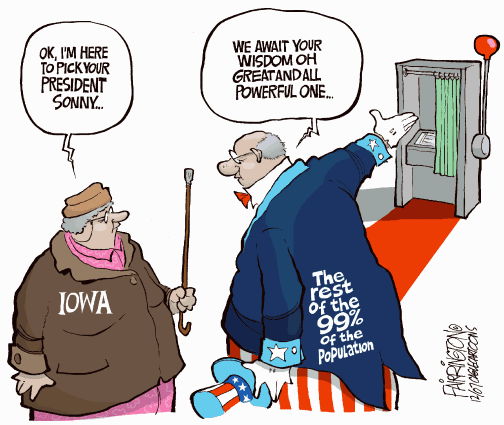 An editorial / By Dale McFeatters Scripps Howard News Service January 02, 2008
But on 6:30 Thursday, if turnout is as expected, 150,000 Iowa Democrats and 80,000 Republicans will gather in public libraries and church basements in 1,784 precincts to propel one or more of a dozen possible candidates to their party's nomination. Or not. Some years, like 2004 and 2000, it works. Other times it doesn't.  Artist Brian Fairrington, Cagle Cartoons Distributed to subscribers for publication by Cagle Cartoons, Inc.
But like little Peterkin and the famous battle, everybody says the caucuses are important, so they are. The two parties' caucuses operate by slightly different rules, with the Democrats' predictably being more complicated. The Democratic rules for caucus chairs run to 13 pages. Straw polls are taken with candidates required to get at least 15 percent of the vote to be considered "viable." Failing that, "supporters of nonviable candidates have the option to join a viable candidate group, join another nonviable candidate group to become viable, join other groups to form an uncommitted group or chose to go nowhere and not be counted." And all that has to be done within 30 minutes. Iowans are serious about their civic duties but they're not going to take all night performing them. The caucus chair then multiplies the number of members in each preference group times the number of delegates allotted that precinct and divides by the number of eligible attendees at the caucus. The candidate with the most delegates wins -- sort of. What the caucus is doing is electing delegates to a later county convention, which in turn chooses delegates for a district convention, then the state convention and finally the national presidential nominating convention by which time Iowa has been all but forgotten. One other thing: The choice of candidate is nonbinding on the delegate. The chair is instructed to adjourn the caucus with, "Thank you all for coming." And we do thank you. We think.
Distributed to subscribers for publication by Scripps Howard News Service, http://www.scrippsnews.com
|